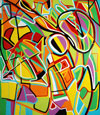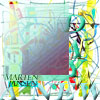Lucretia (1664)
When I first heard that Rembrandt's Lucretia isn't by Rembrandt, I was shocked and in disbelief. Then I took another look at an image of the painting and remembered that I had found it strange that Rembrandt's Lucretia looked like a Southern-European woman, not like the rather floppy-faced Dutch people that Rembrandt would use as models for his biblical figures. It also occurred to me that Lucretia had been given much more elaborate finishing than Rembrandt would seemed to have cared for during the last ten years of his life. Just as I was ready to make a u-turn in my opinion about Lucretia, the following occurred to me:
Lucretia is one of the best paintings ever made. If Rembrandt didn't make it, then who did? Those that attribute the painting to students of Rembrandt have two big problems:
- The style of Lucretia varies far more with the styles of Rembrandt's known students (such as Ferdinand Bol, Willem Drost) than it does with Rembrandt's own style
- The overall quality of the painting (as opposed to the technical details) is far beyond what Rembrandt's known students ever made
The source of the difference in opinion is becoming clear: While scholars like those belonging to the Rembrandt Research Project confine themselves to details ("Look how well Ferdinand Bol has rendered this table cloth. Surely he could paint just as well as Rembrandt!"), one also has to look at a painting as a whole. And as far as the whole is concerned: Lucretia has got Rembrandt all over her.
But how about the problems mentioned above? Lucretia doesn't look Dutch and the painting seems to have too much finishing. In fact, there is another problem. Rembrandt's idol, Peter Paul Rubens, had a natural talent for suggesting motion in his paintings. Rembrandt, who among, ahem, scholars, has the reputation of being so great at suggesting motion, had indeed made countless attempts at suggesting motion in the way Rubens did. To little avail, I'm sorry to say. As a technical genius and tireless worker Rembrandt went as far as he could go, but by nature Rembrandt's style is static. While Rubens was a man of politics, sin, vanity and social success, Rembrandt was moderate, reserved and reflective. While Rubens managed to portray the heinous act of the crucifiction in all it's perverse glory, Rembrandt's violence would always contain a certain grace and politeness. While the knife that Lucretia (1666 - below, right) is holding looks like a letter opener, Lucretia (1664)'s knife looks like a murder weapon.
Compare that with Rembrandt's "The blinding of Samson" (1636). It's a nasty scene, but at the same time bizarre for the undercooled quality that we know so well from Rembrandt: not hardly as effective a painting to portray a violent act, as Lucretia (1664). In fact, the tension in Lucretia (1664) is unique in the work of Rembrandt. While Rembrandt was at his artistic peak during the last ten years of his life, his paintings from that period also show signs of resignation and mellowness. This contrasts with the fanatical quality that Lucretia (1664) has.
It is well known that Rembrandt's students would finish many of Rembrandt's works and the possibility immediately presents itself that Rembrandt set Lucretia up and that a student finished it. Then Lucretia has the unparalleled talent of Rembrandt and the energy of a younger man.
|
|















